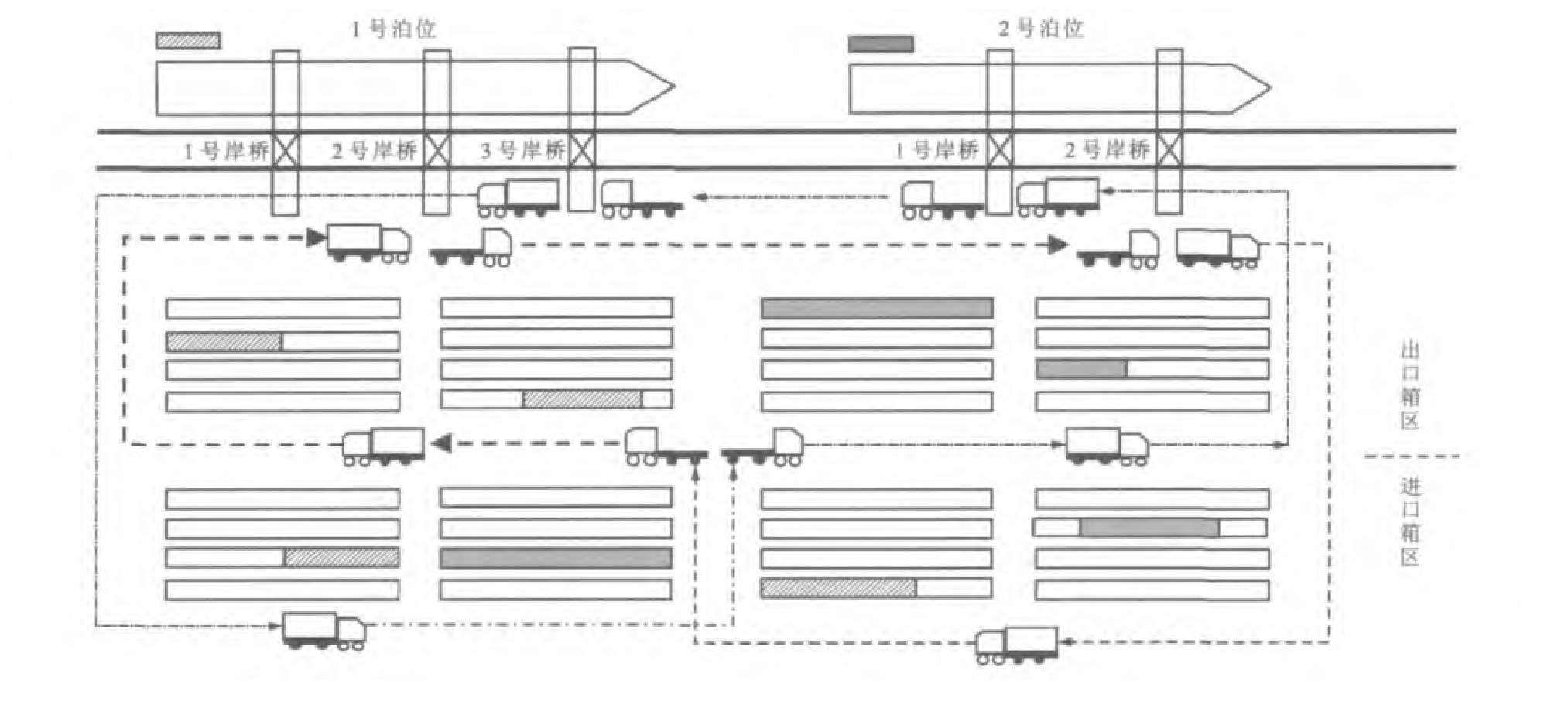Integrated scheduling model of mixed cross-operation for container terminal
-
摘要: 针对集装箱码头进出口作业系统中泊位分配、装卸作业、水平搬运等诸多环节之间的关系, 分析了现有进出口作业系统对集装箱码头生产效率与运营成本的影响。运用系统工程优化理论, 提出混合交叉作业集成调度方法与同步优化技术, 以泊位分配、设备配置、集装箱卡车(集卡)行驶路径为决策变量, 以集装箱码头最小运营成本为目标函数, 建立了三阶段集成调度优化模型, 设计了双层遗传求解算法。在双层遗传算法中, 上层遗传算法用于搜索集装箱码头设施设备的合理配置组合, 下层遗传算法在上层算法的基础上优化集卡行驶路径。计算结果表明: 与独立装卸作业过程相比, 使用混合交叉作业集成调度模型时, 集卡数量为22 veh, 减小了66.2%, 集卡行驶总距离为10 389.8 km, 减小了17.4%;与单独调度方式相比, 使用混合交叉作业集成调度模型时, 集卡行驶总距离减小了14.5%, 码头运营总成本为84 266.2元, 降低了4.6%。可见, 使用集装箱码头混合交叉作业集成调度模型, 能有效提高集装箱码头生产效率, 明显降低运营成本。Abstract: Aiming at the relations among several links such as berth distribution, loading operation and unloading operation and horizontal handling in the import and export operation system of container terminal, the effect of existed import and export operation system on the production efficiency and operation cost of container terminal was analyzed.By using optimization theory of system engineering, the integrated scheduling method of mixed cross-operation and synchronous optimization technology were put forward.The berth distribution, equipment configuration and the driving path of container truck were taken as decision variables, the minimum operation cost of container terminal was taken as objective function, 3-stage integrated scheduling optimization model was established, and the hierarchic genetic algorithm was designed to solve the model.In the hierarchic genetic algorithm, the upper layer genetic algorithm was used to search for the reasonable configuration combinations of facilities and equipments for container terminal, and the lower layer genetic algorithm was used to optimize the driving path of container truck based on the upper layer genetic algorithm.Calculation result indicates that compared with the independent loading and unloading operation process, by using integrated scheduling model of mixed cross-operation, container truck number is 22, and reduces by 66.2%.The total driving distance of container trucks is 10 389.8 km, and decreases by 17.4%.Compared with the single scheduling system, by using integrated scheduling model of mixed cross-operation, the total driving distance of container trucks decreases by 14.5%.The total operation cost of container terminal is 84 266.2 yuan, and reduces by 4.6%.It is clear that by using the integrated scheduling model of mixed cross-operation for container terminal, the production efficiency of container terminal can increase significantly, and the operation cost of container terminal can reduce obviously.
-
表 1 参数取值
Table 1. Parameter values

表 2 优化路径与工作量
Table 2. Optimization paths and operation amounts

表 3 独立装卸作业
Table 3. Independent loading and unloading process

表 4 优化结果对比
Table 4. Comparison of optimization results

-
[1] YAN Wei, HUANG You-fang, CHANG Dao-fang, et al. An investigation into knowledge-based yard crane scheduling for container terminals[J]. Advanced Engineering Informat-ics, 2011, 25(3): 462-471. doi: 10.1016/j.aei.2011.03.001 [2] GUO Xi, HUANG S Y, HSU W J, et al. Dynamic yard crane dispatching in container terminals with predicted vehicle arrival information[J]. Advanced Engineering Informatics, 2011, 25(3): 472-484. doi: 10.1016/j.aei.2011.02.002 [3] SALIDO M A, RODRIGUEZ-MOLINS M, BARBER F. A decision support system for managing combinatorial problems in container terminals[J]. Knowledge-Based Systems, 2012, 29(5): 63-74. https://www.sciencedirect.com/science/article/pii/S0950705111001377 [4] 靳志宏, 李娜. 基于泊位计划的集装箱码头岸桥动态调度优化[J]. 交通运输系统工程与信息, 2011, 11(3): 58-64. doi: 10.3969/j.issn.1009-6744.2011.03.009JIN Zhi-hong, LI Na. Optimazation of quay crane dynamic scheduling based on berth schedules in container terminal[J]. Journal of Transportation Systems Engineering and Informa-tion Technology, 2011, 11(3): 58-64. (in Chinese). doi: 10.3969/j.issn.1009-6744.2011.03.009 [5] CAO Jin-xin, SHI Qi-xin, LEE D H. Integrated quay crane and yard truck schedule problem in container terminals[J]. Tsinghua Science and Technology, 2010, 15(4): 467-474. doi: 10.1016/S1007-0214(10)70089-4 [6] 陈超, 王海燕. 集装箱码头泊位生产运作优化模型[J]. 大连海事大学学报, 2009, 35(4): 52-54, 58. doi: 10.3969/j.issn.1671-7031.2009.04.012CHEN Chao, WANG Hai-yan. An optimal model of container quay berth production operation[J]. Journal of Dalian Mari-time University, 2009, 35(4): 52-54, 58. (in Chinese). doi: 10.3969/j.issn.1671-7031.2009.04.012 [7] 计明军, 靳志宏. 集装箱码头集卡与岸桥协调调度优化[J]. 复旦学报: 自然科学版, 2007, 46(4): 476-480, 488. doi: 10.3969/j.issn.0427-7104.2007.04.011JI Ming-jun, JIN Zhi-hong. A united optimization of crane scheduling and yard trailer routing in a container terminal[J]. Journal of Fudan University: Natural Science, 2007, 46(4): 476-480, 488. (in Chinese). doi: 10.3969/j.issn.0427-7104.2007.04.011 [8] ZENG Qing-cheng, YANG Zhong-zhen. Integrating simula-tion and optimization to schedule loading operations in con-tainer terminals[J]. Computers and Operations Research, 2009, 36(6): 1935-1944. doi: 10.1016/j.cor.2008.06.010 [9] 曾庆成, 杨忠振. 集装箱码头卸船作业调度方案的两阶段禁忌搜索算法[J]. 交通运输工程学报, 2007, 7(2): 109-112, 122. doi: 10.3321/j.issn:1671-1637.2007.02.023ZENG Qing-cheng, YANG Zhong-zhen. Two-phase tabu search algorithm of unloading operation scheduling project incontainer wharf[J]. Journal of Traffic and Transportation Engineering, 2007, 7(2): 109-112, 122. (in Chinese). doi: 10.3321/j.issn:1671-1637.2007.02.023 [10] 周鹏飞, 康海贵. 面向随机环境的集装箱码头泊位-岸桥分配方法[J]. 系统工程理论与实践, 2008, 28(1): 161-169. doi: 10.3321/j.issn:1000-6788.2008.01.024ZHOU Peng-fei, KANG Hai-gui. Study on berth and quay-crane allocation under stochastic environments in container terminal[J]. Systems Engineering-Theory and Practice, 2008, 28(1): 161-169. (in Chinese). doi: 10.3321/j.issn:1000-6788.2008.01.024 [11] KIM K H, PARK Y M. A crane scheduling method for port container terminals[J]. European Journal of Operational Research, 2004, 156(3): 752-768. doi: 10.1016/S0377-2217(03)00133-4 [12] BISH E K. A multiple-crane-constrained scheduling problem in a container terminal[J]. European Journal of Operational Research, 2003, 144(1): 83-107. doi: 10.1016/S0377-2217(01)00382-4 [13] 曾庆成, 胡祥培, 杨忠振. 集装箱码头泊位分配-装卸桥调度干扰管理模型[J]. 系统工程理论与实践, 2010, 30(11): 2026-2035. doi: 10.12011/1000-6788(2010)11-2026ZENG Qing-cheng, HU Xiang-pei, YANG Zhong-zhen. Model for disruption management of berth allocation and quay crane scheduling in container terminals[J]. Systems Engin-eering-Theory and Practice, 2010, 30(11): 2026-2035. (in Chinese). doi: 10.12011/1000-6788(2010)11-2026 [14] NISHIMURA E, IMAI A, PAPADIMITRIOU S. Yard trailer routing at a maritime container terminal[J]. Transportation Research Part E: Logistics and Transportation Review, 2005, 41(1): 53-76. doi: 10.1016/j.tre.2003.12.002 [15] GOODCHILD A V, DAGANZO C F. Double-cycling strat-egies for container ships and their effect on ship loading and unloading operations[J]. Transportation Science, 2006, 40(4): 473-483. doi: 10.1287/trsc.1060.0148 [16] GOODCHILD A V, DAGANZO C F. Crane double cycling in container ports: planning methods and evaluation[J]. Transportation Research Part B: Methodological, 2007, 41(8): 875-891. doi: 10.1016/j.trb.2007.02.006 [17] 曾庆成, 杨忠振, 陆靖. 集装箱码头同贝同步装卸调度模型与算法[J]. 交通运输工程学报, 2010, 10(1): 88-93. http://transport.chd.edu.cn/article/id/201001016ZENG Qing-cheng, YANG Zhong-zhen, LU Jing. Sched-uling model and algorithm of integrating loading and unloading operations in same ship-bay at container terminal[J]. Journal of Traffic and Transportation Engineering, 2010, 10(1): 88-93. (in Chinese). http://transport.chd.edu.cn/article/id/201001016 [18] ZENG Qing-cheng, YANG Zhong-zhen, LAI Lu-yuan. Models and algorithms for multi-crane oriented scheduling method in container terminals[J]. Transport Policy, 2009, 16(5): 271-278. doi: 10.1016/j.tranpol.2009.08.006 [19] 李娜. 集装箱码头连续泊位与岸桥调度联合优化研究[D]. 大连: 大连海事大学, 2011.LI Na. The combined scheduling of coutinuous berth and quay crane at container terminal[D]. Dalian: Dalian Maritime Uni-versity, 2011. (in Chinese). [20] 焦宇, 康与涛, 尹小贝, 等. 港口交通资源承载力预测预警模型[J]. 交通运输工程学报, 2012, 12(2): 84-92. http://transport.chd.edu.cn/article/id/201202012JIAO YU, KANG YU-tao, YIN Xiao-bei, et al. Forecasting and early-warning model of port traffic resource carrying capacity[J]. Journal of Traffic and Transportation Engineer-ing, 2012, 12(2): 84-92. (in Chinese). http://transport.chd.edu.cn/article/id/201202012 -





 下载:
下载:







